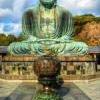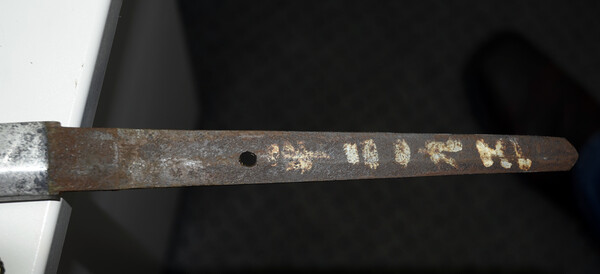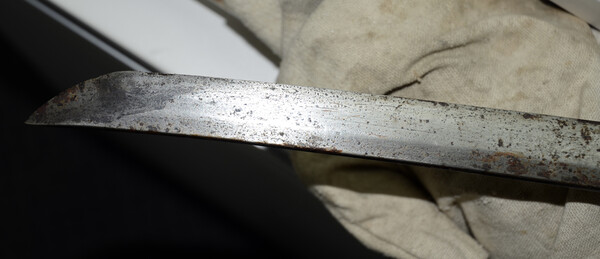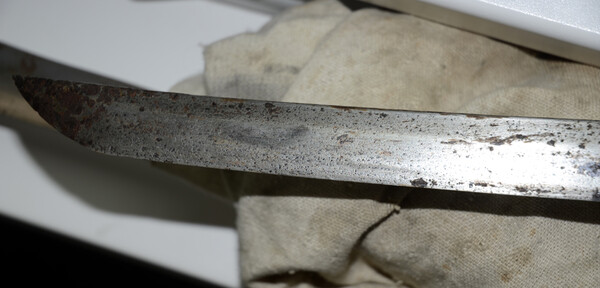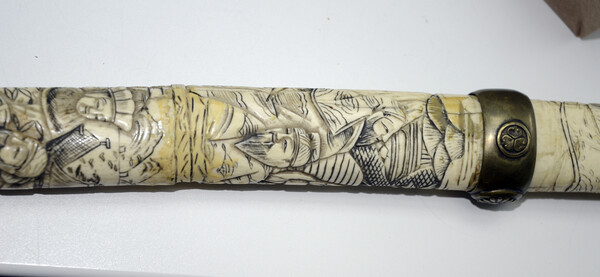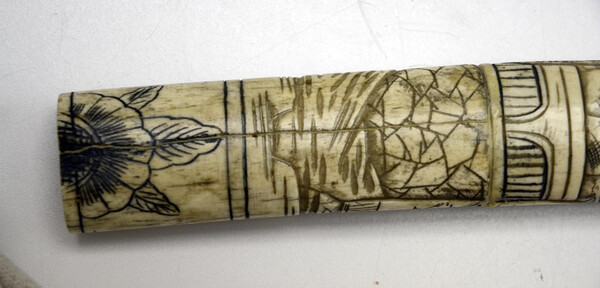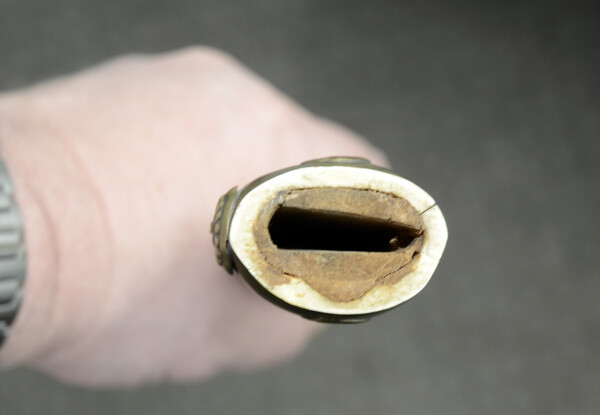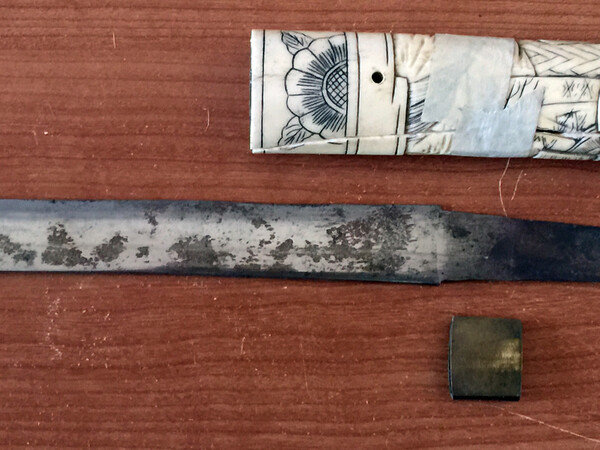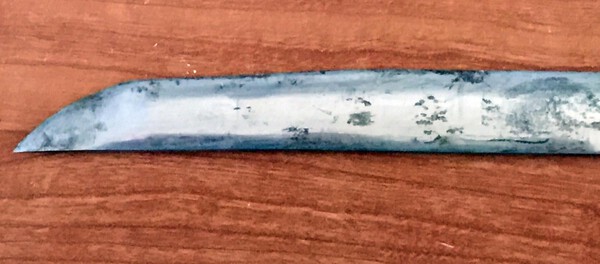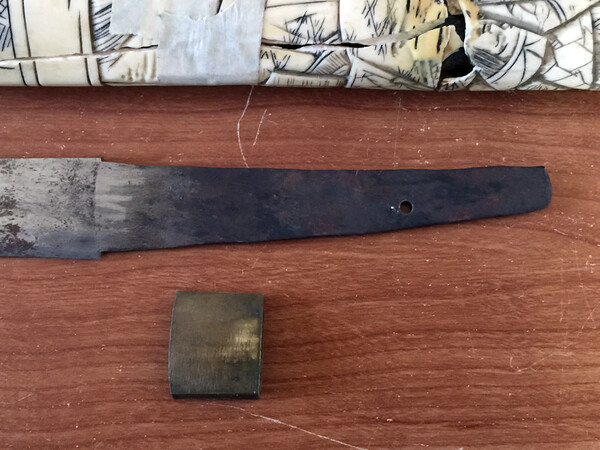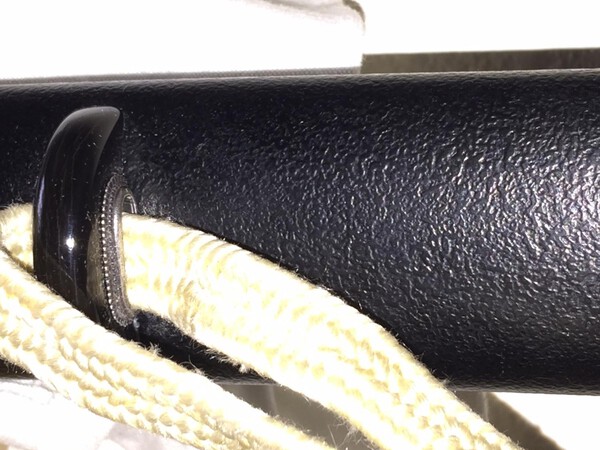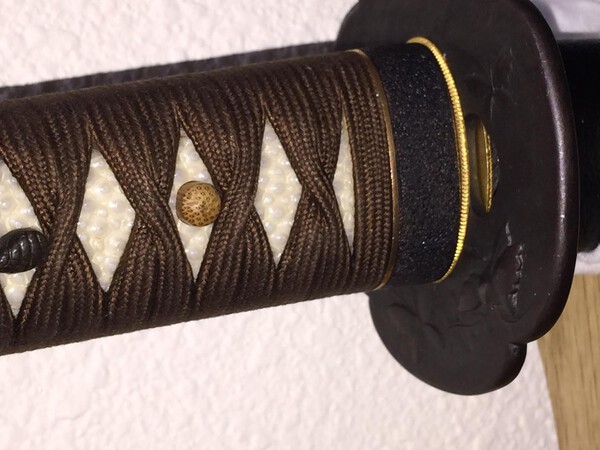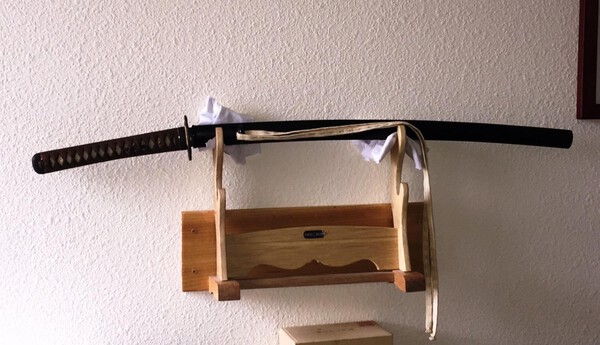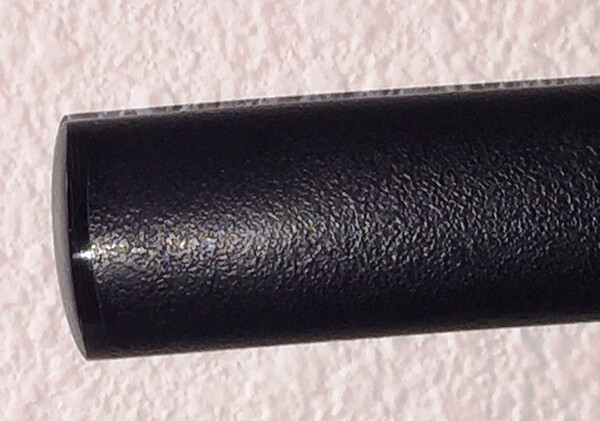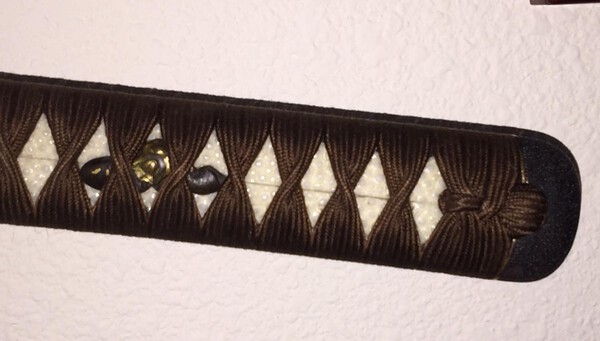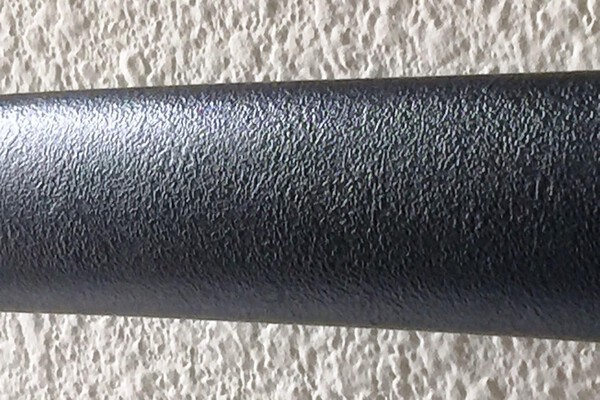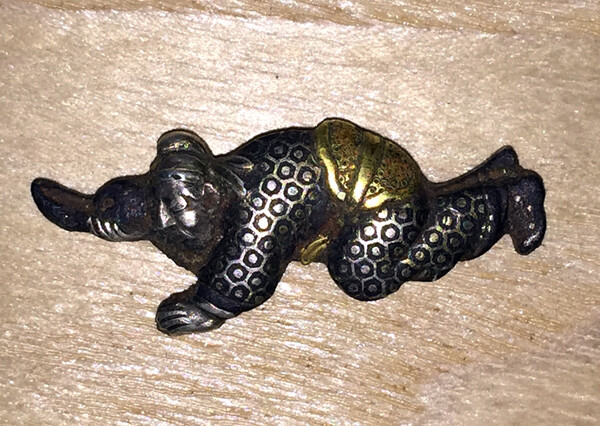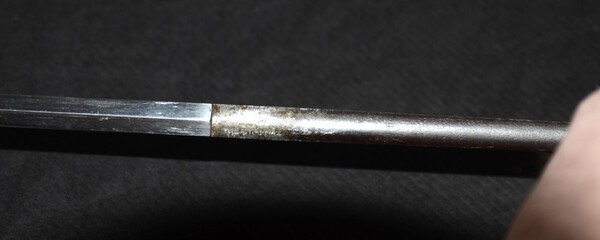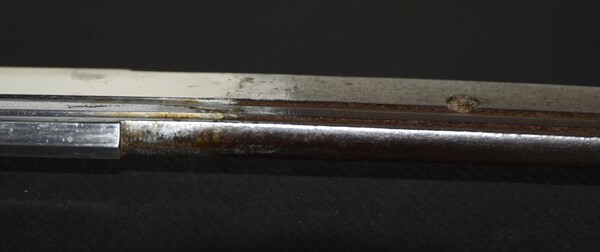-
Posts
599 -
Joined
-
Last visited
Everything posted by CurtisR
-
Hello All, Hoping your weeks went well...I was thinking about a subject that I haven't seen discussed (maybe I missed it?); Is there a correlation of the diameter of tsuba to the given period of the blade perhaps? To clarify, for instance an Edo tsuba - during the time when art "generally" was held in esteem relating to tosogu of moderate to 'good' quality vs. the time of say, Muromachi when the tsuba was probably iron and fairly un-adorned (unless for one of higher rank). made with the probability that the tsuba would be used in combat (and (?) larger) and the attractiveness of the piece not so important? Just curious - I've looked at different period tsuba but can't come to a conclusion...maybe it also has to do with the Ryuha of the owner and/or the tsubashi who made the piece. Any thoughts here? Best, Curtis R.
-
Well I'm very happy that my post led to some learning (for me at least)...when I first saw the "wakizashi" I had the distinct feeling that 'someone got ripped off'...and sure enough! I've learned a tremendous amount from those here and -well - to put it bluntly the things stunk . The purchaser asked me about it only after he'd bought it (AKA "oooo - look at the shiny thing! It must be worth a ton of money!"). I am hoping that when he gets the verification that I sent him by text, he'll "slow his roll" next time and at least ask before giving $. NOT that I claim to know much, really, but I'm improving. I intend to send one photo of Brian's beauty to show him the difference. And yes, it's VERY interesting just how long the fake market has been in action...probably targeting sailors, day-tourists and the like who then passed them down as treasured heirlooms . Regardless, just as in netsuke, there is a huge difference in honest, skilled work vs. junk. Many thanks :beer: Curtis R.
-
Thanks Grey ~ that was my reaction as well. Glad it isn't mine!! Just thought I'd confirm - It is one uuuuugly beast . I'm starting to trust my instincts a bit more now.... Best Regards, Curtis R.
-
Good evening everyone ~ Haven't run into this problem before, but the nakago is thickly coated in red (active) rust and possibly was in a fire? Regardless, I can barely see the start of mei peeking out from underneath....my question is: how do I treat the red rust to prevent further damage, and is it "safe" to try soft brushes around the mei area to expose it? Seems to me that if I let it continue it will simply dissolve the nakago, so why not try it? Suggestions welcome!! Curtis R.
-
Happy weekend, all! Well here's a mystery (to me at least..) a Wakizashi with a terrible blade, probably early 1900's - machined mekugi-ana, and encased in the pictured shirasaya. I did some research and find both Japanese examples of this type of work (with some of the exact patterns) in oxen bone, but ALSO some claiming to be Chinese in origin (and in this example, wearing chinese styled robes and head-gear). THEN....the brass collars (2) holding sections of bone together, but with raised Tokugawa mon. The scrimshaw work isn't "bad" but doesn't really have life to it. I did the hot needle test, and it's not plastic. There is very tight grain, and so it's not composite. My kantai guess is that it's a tourist-trade piece from between 1890's and the 1950's...the blade *might* have a hamon but the nakago is very crude and - to use the old pun - the shirasaya is like putting lipstick (saya and mon rings) on a pig (the blade)". Would just like to know from the wise and experienced minds here if I've gotten in right? There may be some value in the fittings (although cracked) but none in the blade.....IMHO. Fire away, and thanks in advance ~~ Curtis R
-
Hi Lotus - Just a reminder to sign all of your posts .... And to continue, I haven't given the info. because I can't remember his Sensei's name - he can, but I cannot. I spoke with him last night and he was up all night finishing an order for a sword shop he works closely with...that I DO know. He's "an animal" when it comes to work - it is his full time (and more) occupation. I suggested a private message out of politeness to HIM, not to hide something as I think you're implying. Do you feel that the koshirae above (mine ) are lacking somehow? If so, please let's discuss it! That's why we're here, right? I will mention to Koga-san that you'd like to know who he's trained by and with though (and then I'll write it down so I remember ). I will state this very openly though; Hans-san and I have become friends for many reasons beyond the sword world during the time he spent making my koshirae, but I do not have any financial interest in his business or for promoting his work. I just know that finding a good - and truly reasonably priced - artisan can be difficult and so I've shared my experience here. He was referred to me by another board-member here who also does beautiful work (Jeffery Ching). Perhaps this will clear matters: I know MY Senseis names but Hans does not remember, I'd bet :beer: on that lol. That's what I truly love about the NMB - it's a free exchange of info. and a place of learning. And I've "met" some great folks here. Bonus! Curtis R.
-
He is on the board here (2 above this one / Koga Hansuke) - I'm sure he'd be fine if you message him and ask.... Curtis R.
-
Ah, here (above) is Koga-san...SAS, please coordinate with him. I'm sure you'll be able to come up with a great plan . As for the suggestions made, he helped me pick the finish and look of saya, as well as picking a much better pair (more beautiful and fitting the theme) of menuki than those I'd sent along. Also the style of wrap, since the sword would actually be used for Iai and not just presentation. He also hand-carved the shitagi (sp?) core the the tsuka to fit the f/k and yet be balanced with the rest of the koshirae for practice, but that also feels like it's alive. Curtis R.
-
I re-examined the seppa and it is only perhaps 2mm larger than it should be Alex - and thank you for the warning. The seppa - also - is only slightly larger on one hitsuana, and not both, which should make fitting it a snap. Yes Jamie - that's it!! When I was writing the post I couldn't recall for the life of me. I will attach a photo alter this evening, as well as a few more photos. As for the price of the entire koshirae, SAS ~~~ it was not inexpensive but absolutely worth it. To be polite in my answer (value is different to each is my point here...) I will say it was less than half of the price I pair for the blade itself, which was a bargain to begin with. IMHO, with a beautiful koshirae the monetary value of the blade goes up from my understanding. I will also confess that Koga-san has an amazing eye for balance, history and beauty and made several suggestions/improvements that I'd NEVER have thought of. And he was correct :) . I can elaborate if you'd like, but I can assure you it wasn't to "up-sell". Curtis R.
-
Chris, the seppa cover a bit of the hitsuana...it's gendai and is actually larger than it looks, as is the tsuba - it's very nce construction from iron, and although I haven't cut down the seppa, it still has a nice feel. I agree that I should probably fit the seppa properly. For Guido and Steve, correct - I did not send the blade to Japan - the wood for the saya was sent to a wood craftsman here in the US (who I DID send the blade to), who cut the space for nakago and the dimensions and fit for the blade in the saya. Might seem like a bit of a long process but it was much easier than sending the blade to Japan! And Chris is absolutely right...it's the change in humidity that it's adjusting to - it will of course fit flush now but needs a bit of time to have the RIGHT fit to be drawn smoothly, yet not to rattle or be loose at koiguchi. It'll be just right very soon. And Ken, yes - it was very easy customs-wise to send back and forth...as long as there's no blade. Oh - forgot to mebntion that he also carved a woodent "insert blade" (can't recall the term) for the hoshirae which kept everything connected during shipping. One very important part of the process is to have the Tsuka and saya fitted very well before traveling on to Japan for finish. I was a little hesitant/skeptical also, but the proof is in the holding and examination . I can tell you that after using chinese blades for Iai, I wouldn't hesitate to use this sword --- not for tamishigiri of sourse but for kata, certainly! Mr. Koga can be found on facebook under "koga-bijutsu". Curtis R.
-
Although it's taken a while, I received the koshirae for my Aikihiro katana made by Hans Koga in Chiba, Japan. I provided the f/k and tsuba as well as the hibaki and he made the rest. IMHO, it came out very beautifully and feels amazing. The saya is done by hand in ishimeji (wood grain or like tree bark) pattern, and the horn koiguchi and kojiri both shaped and fitted, and the tsuka done with a full-wrap same and new shitaji cut and shaped. The ito is mid-grade silk. I'm not forcing the blade in and am letting all of the parts "get to know each other", but the fit really nicely! Also included were hand-sewn bags for shirasaya and koshirae from old, very pretty kimono obi. I can say that dealing with this was a bit of a process, having not sent the blade to Japan but he nailed it for fit and was a true pleasure to deal with. Curtis R.
-
Greetings ~ I ran into this blade the other day (not kissaki first ) and it's stumping me a bit...As I've gotten better at translation, I've also learned that without the 'complete' set, the meaning can get very vague or not make sense...which is what I have here. Can those with higher wisdom & experience please tell me what the mei "might" be for this wakizashi? All signs lead to it being perhaps shinshinto, but the nakago was shortened & re-shaped (IMHO) in a rough manner, and I can't make heads or tails of the kanji that remain. I can post more pics as well but thought I'd save for the "general nihonto" section..... Many thanks, Curtis R.
-
Thank you David & John! Yes, it's very unfortunate that the damage is pretty bad on one of them - to me it appears they were in a humid area for a long time (they were originally - recently - in Japan)...I think perhaps a soft brush might take some of the rust off but I haven't tried it. They are very pretty under magnification, and great care was used to make them...pretty awesome . Also, thanks for the tip on iron menuki being sought-after. As I said I'm not sure if I'll hang on to them but very fun to study regardless and they have a very solid feel to them. I can also see the different layering of materials because of the damage. Fascinating little guys, even though I'd rather the one was in better shape. Again, many thanks - I'm always blown away by the deep, wide ranges of knowledge here :beer: Curtis
-
Wild - Thank you all for the information...and what a cool legend / story! I don't think I paid too much for them now either . I'm debating whether to keep them or to put them up for sale, but I like them even more now...I had never heard of being made to crawl between the legs, but the baskets and 'down on all fours' depiction makes sense now. VERY cool! Thanks guys and hope you're all having a good end to the week! Oh, and if anyone knows about the signature, please feel free to come on board. I'm still researching also. Cheers, Curtis R.
-
Hello All, I've come to possess this menuki pair and the work - at least where age hasn't gotten the better of it - seems very nice, even under a loupe. They appear to be iron (magnetic) but also decorated with silver foiled over copper, and gold as well. I'm unsure of the theme but it appears to be a Samurai listening to a seashell (?) and the other a samurai on his knees being blocked from two vases of treasure (?) by an unknown person/samurai with a silver staff. On the ura of one menuki is a signature plate (in gold) which reads "Higashiyama". I've tried to research this and it seems to be not only a place (near Kyoto long ago) but also a period in the late 1500's. Perhaps also a school of menuki craftsmen? I've tried to capture the omote and ura of each in the attached pics, and would greatly appreciate any information or thoughts on them. They are finely detailed, even showing the individual hairs of the mustache. Their length is approx. 3.5cm. I initially though early Edo but after looking further at the corrosion and style I'm guessing perhaps pre-Edo. Many thanks in advance ~~ Curtis R.
-
Agreed Chris! And no worries...hey, that's why they hold Shinsa "in-hand" vs. "Please submit your photos", right?? All is good, and I'm looking forward to learning more....which in the end is what it's all about, IMHO! Thanks to all ~~ Curtis R.
-
Thank you all for the input - and Robert, that's the # I see also... To Brian, I can imagine it's very, very difficult as you say and probably the wrong road to go down. But they are old and cool .
-
Hmmmmm....well, certainly getting mixed reviews between Japan and here Chris, but with even my limited knowledge I agree that it hasn't been polished much at all. I think I'll let it lay in state until Shinsa and then hopefully we'll both know for sure . I still really like it regardless, and I guess that's the "main" thing, yes? Thanks! Curtis R.
-
-
Greetings, This kojiri (and the saya it was attached to) are somewhat interesting I think...it shows both Kikumon and Kirimon in gold. I know that the Hdeyoshi kirimon had a 5/7/5 leaf pattern, and I can't quite tell if this one does as well. It is also displayed on the fuchi (which I'll post later). The kojiri is old iron, as is the fuchi (I don't have the kashira sadly) but "how old" is the question. When I first obtained it I thought that the fittings were pooly done, but if very old, is it possible that they were done as best they could be? The katana that came with it is a beauty, although how nice remains a mystery until shinsa. I don't have the tsuba ( ) so can't even quess what it might have been. A friend - with better eyes than I have - said he believes the kikumon has 14 petals, but I'm going to use a loupe to see if I can see the same.... Thoughts or comments are very welcome of course. Enjoy! Curtis R.
-
Well I apologize for the delay....I FINALLY got the photos of the hamachi and munemachi as requested by Chris. I forgot to bring those of the nakago end with me, but will post later tonight. Please enjoy, and as always, comments are welcome. As an aside, I did send the previously posted photos to a well-respected member of the Nihonto community and he gave me his opinion, believing it is not a shinto copy but probably koto. I'm also heading over to the tosogu section and will post pics of the kojiri from the saya, as well as some of the saya itself which has an identified pattern. What is interesting about the kojiri (and fuchi - which again, I'll post later) is that it displays both Mikumon and Kirimon, and possibly a river? They are iron, and old - I'm not claiming they have lieneage to the Hideyoshi clan, but it's a possiblity . Please feel free to take a peek ~~ Cheers, Curtis R.
-
Will Do Chris - I'll take them this weekend and post ~~ Curtis R.
-
To my eye, it appears to be Jizo boshi, but...... Curtis R.
-
Also, as a point to note while in a Dojo (or perhaps a home with one), if the sword kissaki is pointing toward the Shomen, it's very rude. Had my behind ripped about this while training in MJER. Curtis R.


